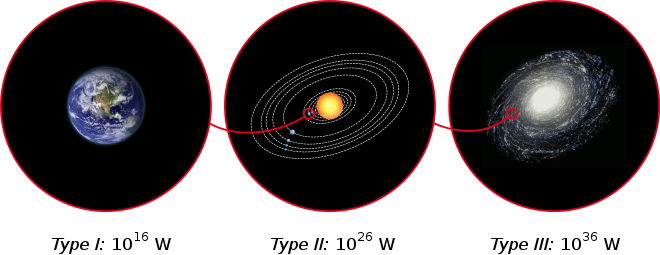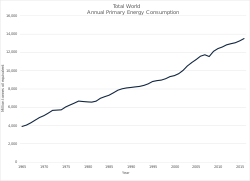卡爾達肖夫指數
| 未來學 |
|---|
 |
| 概念 |
| 工具 |
| 科技評估及預測 |
卡爾達肖夫指數(英語:Kardashev Scale,俄語:Шкала Кардашёва,又譯卡爾達肖夫尺度)是根據一個文明所能夠利用的能源量級,來量度文明層次及技術先進程度的一種假說。1964年蘇聯天文學家尼古拉·卡爾達肖夫首先提出用能量級把文明分成三個量級:I型、II型和III型。I型文明使用在它的故鄉行星所有可用的能量,II型文明利用它的行星所圍繞的恆星所有的能量,III型文明則利用它所處星系的所有能量。一般認為人類文明現在接近但尚未達到I型文明,經過其公式換算目前大約處在0.75級左右[來源請求]。
定義
[編輯]在1964年由蘇聯天文學家尼古拉·卡爾達肖夫首先提出定義文明的三個層次,根據各個文明使用能源功率數量的量級:
- III型 — 文明對一個星系所駕馭的能量大約是 1036 W。這個數字是有極多變數的,因為星系的體積在變化中。卡爾達肖夫指數原定義為 4×1037 W。
在現階段,上述文明類別純為假定。但是卡爾達肖夫指數被搜尋地外文明計劃研究人員、科幻小說作家和預言家用來作理論基礎。

人類文明的現狀
[編輯]
加來道雄認為,人類可能在100到200年[來源請求]左右達到I型狀態,在幾千年後達到II型狀態,而約在10萬至100萬年後達到III型狀態。[2]
卡爾·薩根建議定義中間值(不考慮在卡爾達肖夫的原指數),由類型I(1016 W),類型II(1026 W)和類型III(1036 W)的值來做內插和外插,得出下面的公式:
- ,
其中的K是一個文明的卡爾達肖夫指數,P 是它使用的電力,以瓦特爲單位。他計算出人類文明類型指數(在1973年)是0.7左右,用外推法(顯然1970年代人類使用了10太瓦(TW)的數值)。[3]
2012年,總世界能源消耗量為553艾焦(553×1018 J=153,661 TWh),相當於平均功耗為17.54太瓦(1.504×1013 W ,或0.724上的卡爾達肖夫指數)。從1973年到2012年該指數每年平均增長0.0008左右。[4]
地球的總光合生產力是大約1500至2250TW之間,或每年47,300-71,000艾焦(EJ),相當於0.9卡爾達肖夫指數。
註釋
[編輯]- ^ 1.0 1.1 Lemarchand, Guillermo A. Detectability of Extraterrestrial Technological Activities. Coseti. [2013-01-29]. (原始內容存檔於2019-03-18)..
- ^ Kaku, Michio. The Physics of Interstellar Travel: To one day, reach the stars.. 2010 [2010-08-29]. (原始內容存檔於2014-02-10).
- ^ Sagan, Carl. Jerome Agel , 編. Cosmic Connection: An Extraterrestrial Perspective. Freeman J. Dyson, David Morrison. Cambridge Press. October 2000 [1973] [2008-01-01]. ISBN 0-521-78303-8.
- ^ Primary Energy Consumption 2008-2012' Total Primary Energy Consumption 2008-2012 請檢查
|url=值 (幫助) (cfm). Statistical Review of World Energy 2008-2012. [2015-07-22]. (原始內容存檔於2013-06-14).
參考文獻
[編輯]- Кардашёв Н. С. Космология и цивилизации // Древняя астрономия, небо и человек: тезисы докладов международной научно-методической конференции. — М., 1997. (俄文)
- Holdren J. P. Environmental Change and the Human Condition // Bulletin of the American Academy of Arts and Sciences. — 2003. — Iss. Fall 2003. — P. 24—31.
延伸閱讀
[編輯]- Dyson, Freeman J. Energy in the Universe Article in September 1971 Scientific American magazine (Special September Issue on Energy)
- Rusinek, Marvin. Energy Consumption of Europe. The Physics Factbook. 1998 [2017-02-26]. (原始內容存檔於2018-12-16).
- Wind Powering America (頁面存檔備份,存於互聯網檔案館)
- Clean Energy for Planetary Survival: International Development Research Centre
- LBL Scientists Research Global Warming (頁面存檔備份,存於互聯網檔案館)
- E³ Handbook
- Clarke H2 energy systems
- Holdren, John P.; Carl Kaysen. Environmental Change and the Human Condition (PDF). Bulletin Fall: 24–31. 2003 [2006-08-10]. (原始內容 (PDF)存檔於2006-07-14).
- Dordrecht, D. Exponential Expansion: Galactic Destiny or Technological Hubris?. B. R. Finney, M. D. Papagiannis (編). The Search for Extraterrestrial Life: Recent Developments. Reidel Publ. Co. 1985: 465–463.
- Shkadov Thruster (頁面存檔備份,存於互聯網檔案館)
- Korotayev, A.; Malkov, A.; Khaltourina, D. Introduction to Social Macrodynamics: Compact Macromodels of the World System Growth. Moscow: URSS. 2006 [2017-02-26]. ISBN 5-484-00414-4. (原始內容存檔於2008-03-07).
- Kardashev, Nikolai. Cosmology and Civilizations. Astrophysics and Space Science. March 1997, 252: 25. doi:10.1023/A:1000837427320.
- Supercivilizations as Possible Products of the Progressive Evolution of Matter: also by Kardashev
- Search for Artificial Stellar Sources of Infrared Radiation, by Freeman J. Dyson
- The Radio Search For Intelligent Extraterrestral Life, by Frank Drake
- Freitas Jr., Robert A. Energy and Culture (chapter 15).
- Griffin, John. Operation TOGA: Type One Go Ahead. ISBN 1-4502-0702-2.
參見
[編輯]外部連結
[編輯]- Kardashev civilizations (頁面存檔備份,存於互聯網檔案館)
- Astrobiology: The Living Universe
- Detectability of Extraterrestrial Technological Activities(頁面存檔備份,存於互聯網檔案館)
- Flash Animation on Civilizations (頁面存檔備份,存於互聯網檔案館)
- After Kardashev: Farewell to Super Civilizations
- Exotic Civilizations: Beyond Kardashev
- Description of civilization types from Dr. Michio Kaku(頁面存檔備份,存於互聯網檔案館)
- Search for Type III civilizations

